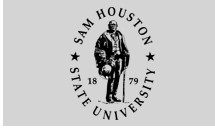SHSU Gets Seventh Active National Science Foundation Grant
The National Science Foundation, with an annual budget of $5.92
billion, funds specific research proposals that have been judged
the most promising in the United States by a rigorous and objective
merit-review system.
The foundation's goal is to keep "the United States at the leading
edge of discovery in a wide range of scientific areas, from astronomy
to geology to zoology."
The foundation says its job is to "determine where the frontiers
are, identify the leading U.S. pioneers in these fields and provide
money and equipment to help them continue."
It is no wonder then, that officials at Sam Houston State University
are especially proud that SHSU now has seven National Science
Foundation Awards totaling almost $2 million, including one announced
this semester.
"NSF grants are one of the true gold standards for scientific
research in the academy," said David Payne, provost and vice
president for academic affairs at SHSU. "The growth in the number
of such grants is a clear sign of the increasing quality of leading
edge scientific research being conducted here."
The latest award is $599,980 for a four-year program entitled
Peers Enhancing their Education through Research and
Scholarship (PEERS). Brian
Loft, assistant professor in mathematics and statistics, is the
principal investigator. Melinda Holt, associate professor in
mathematics and statistics, and Anne Gaillard, assistant professor
in biological sciences, are co-principal investigators.
The goal of PEERS is to increase the number of well-educated
and skilled employees in technical areas of national need based
on an analysis of the dominant industries in our region. Twenty-two
undergraduate and 10 graduate students will receive scholarships
of up to $5,500 for each of the program's four years.
PEERS uses an interdisciplinary team of faculty members, student
support specialists and industry representatives working together
to recruit and nurture the PEERS scholars. Special features of
the program include undergraduate research, tutoring services,
faculty and industry mentors, social events, professional development
workshops and student travel.
An emphasis with PEERS, as with each of the seven NSF grants
at SHSU, is involvement of graduate and undergraduate students
in research.
"With some there is the misperception that research has a negative
effect on teaching," said Jaimie Hebert, dean of the College
of Arts and Sciences. "Research has a positive effect on the
teaching mission because it almost always involves students and
it keeps faculty members current in their disciplines."
All seven of the NSF projects are housed in the College of Arts
and Sciences. They include:
Electronic Activity of Components of Lithium-Ion Batteries. Principal investigator is Gan Liang, professor in physics.
Grant amount is $133,127. "This project will provide a better understanding
of the origins of electronic activity of components of Lithium-ion
batteries," said Liang. "It can potentially produce breakthroughs
in the application of these materials for use in the next
generation of Lithium-ion batteries."
Modeling Semiconductor Devices in Strong Magnetic
Fields. Principal investigator is Barry Friedman, professor of physics.
Grant amount is $125,000 with an additional $78,000 from
the Texas Advanced Research Program. "This work will lead to a better
understanding of electron-electron repulsion in solid state materials," said
Friedman. "This interaction is very significant in the high
temperature superconductors and other oxide materials that
are potentially of profound technological importance."
Biodiversity Study of Insects and their Gregarine
Parasites. Principal investigator is Tamara J. Cook, associate professor
in biological sciences, with co-principal investigators Jerry
L. Cook, associate professor in biological sciences and Sibyl
Bucheli, visiting professor in biological sciences, and collaborator
Richard Clopton of Peru State College of Nebraska. The grant
amount is $259,000. "The project samples gregarine parasite biodiversity
within nine ecosystems within the Primitive Big Thicket of Texas," said
Tamara Cook. "This project will more than double the existing
gregarine specimen base."
Research Experiences for Undergraduates in Experimental
Field Biology. Principal investigator is Diane Neudorf, associate
professor in biological sciences, with co-principal investigator
William Lutterschmidt, associate professor in biological sciences.
The grant amount is $287,137. "This grant will provide eight undergraduate
students each summer for four years with an enjoyable and productive
research experience in experimental field biology," said Neudorf. "Our
goal is to foster an interest and enthusiasm for pursuing
graduate studies in biology and careers in research."
Long-term Undergraduate Research Experience (LURE)
in Mathematics. Principal investigator is Ken Smith, professor in mathematics
and statistics. The grant amount is $300,000. "The LURE model
emphasizes the early recruitment of undergraduates to mathematical
research and the cultivation of interest in the mathematical
sciences," said Smith. Collaborating faculty are from Central
Michigan University, Coppin State University, Olin College,
and the University of Richmond.
Adaptive Kernels for Partial Differential Equation
Models in Image Denoising: Construction and Algorithms. Principal
investigator is Jianzhong Wang. The grant amount is $168,645. "This research
supports the national interest in nanotechnology and information
technology," said Wang. "Its possible application is in improving
digital images/videos for low-cost security cameras, mobile
digital TV, and cell-video phones, which are useful in homeland
security, U. S. border monitoring, and Department of Defense
applications."
Delia Gallinaro, project manager in research and special programs,
said that amassing the current list of NSF grants was no accident.
NSF grants are among the highest measurement of scholarly research
for any university, she said, and SHSU wanted to compete with
research-intensive institutions.
"The university initiative on promoting scholarly research started
when Dr. Gaertner became president," said Gallinaro. "Using internal
grants to 'enhance' external research grant applications was a
way to develop this initiative. After several years of encouraging
faculty to apply, and sometimes re-apply, this year the work has
come to fruition with very positive results."
—END—
SHSU Media Contact: Frank Krystyniak
Oct. 15, 2007
Please send comments, corrections, news tips to Today@Sam.edu.
|


